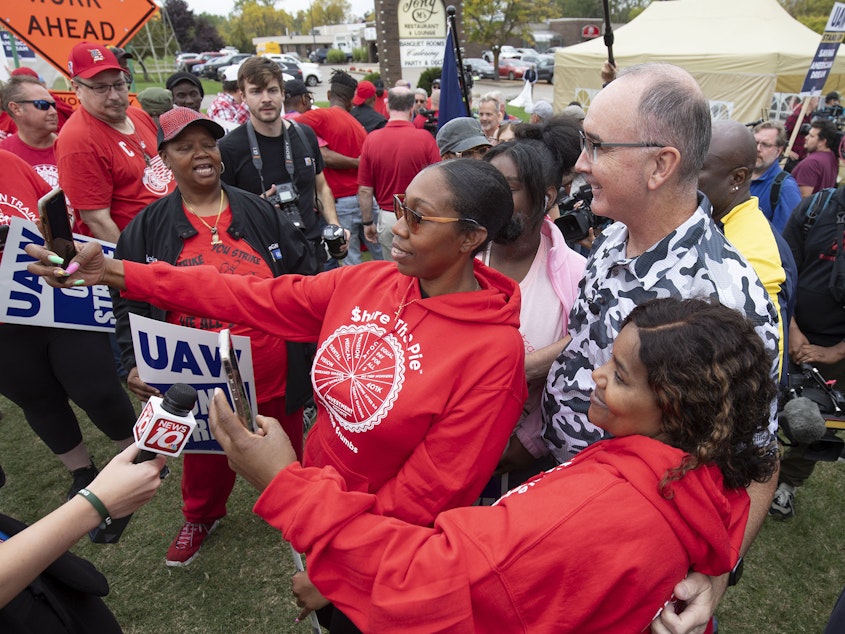GM autoworkers approve new contract, securing wage increases

Unionized auto workers at General Motors have voted to ratify a new contract, finalizing wage gains of at least 25% over the next four years, according to the UAW's vote-ratification tracker.
Although the contract reflects the biggest victory for the union in decades, a sizeable minority of workers were frustrated that the union didn't win back more of the benefits and perks that previous generations of autoworkers enjoyed.
Ford and Stellantis workers are still casting votes on their contracts, which are broadly similar. Results so far show stronger support for those contracts, with more than 60% favoring ratification at both companies.
Victory after unusual battle
The UAW's historic strike against all three Detroit automakers began on September 15, after contentious and unusually public negotiations. Workers at three assembly plants, one per company, walked off the job and joined picket lines in the wee hours of that Friday morning.
Sponsored
Usually, the UAW targets a single company for negotiations and a possible strike, then expects the other two companies to reach similar deals. But these were not usual negotiations.
Shawn Fain, a fiery reformer with big ambitions for the UAW, was elected to lead the union earlier this year as it worked to shake off a deeply damaging corruption scandal. He brought a new attitude, newly combative rhetoric, and a new set of strategies.
Sensing a rare opportunity for significant gains, he laid out eye-popping targets for the union: Raises north of 40% over 4 years, a return of pensions and retiree health care for all workers, a 32-hour workweek, guaranteed cost of living increases tied to inflation.
Instead of targeting one company, he insisted on talking to all three. Instead of keeping negotiations secret, he offered updates on what was on the table in repeated Facebook Live sessions aimed at union members. Instead of pursuing a close and amicable relationship with the automakers, he framed the talks as a war, with the companies as the enemy — the working class against the billionaire class, with the soul of America at stake.
And then, instead of going on strike everywhere at once, he held his fire. He started the strike at just a few facilities, and expanded it gradually and unpredictably. It kept the strike in the headlines, kept the companies on their toes, and kept the cost of being on strike low enough that the union could settle in for the long haul.
Sponsored
The companies were frustrated, and occasionally enraged. They accused Fain of misrepresenting their offers, skipping out on meetings and spending more time chasing headlines than working toward a deal. But he was undeterred.
Some industry observers also argued that Fain was setting the membership's expectations so high that it could make it hard to get an eventual deal ratified; after months of being urged to think bigger, would workers be willing to accept a partial victory?
A compromise deal
Ultimately, the union did not win everything it had on its ambitious wish list. Neither retiree health care nor pensions made a comeback — although UAW members with 401Ks will now get a contribution equal to 10% of their pay up to 40 hours a week, with no required match. The 32-hour-workweek was a bust. (Fain still believes in it, he told members in a recent Facebook Live.)
But workers will get pay increases of at least 25% over the course of the contract. On top of that, they will also receive cost-of-living increases, which are tied to inflation. All told, long-time workers should see pay rise by about 33%, while some newer workers and temps who currently make less money will see their pay more than double. And the union secured guarantees that at least at some battery plants, EV batteries will be made by unionized workers.
Sponsored
Ratification at GM was a surprisingly hard sell for the union. Some senior employees wanted a larger and more immediate pay boost — the wage gains are bigger for newer hires — or a bigger ratification bonus. Other workers worry about long shifts, inadequate time off, or remaining on temp status even after the contract is in place.
Several major GM plants rejected the proposed contract by wide margins. But approval is based on a simple majority, and across the company, a majority of workers were in favor.
Deal will ripple throughout auto industry
Each company's contract is slightly different — Stellantis, for instance, allows factory workers to lease Stellantis vehicles with the same perks as managers. And each company's contract is voted on separately.
But for now, at least one company has locked in a deal. The UAW's wage gains are expected to send ripple effects through the auto industry for years to come, pushing up wages even for nonunionized workers as companies compete for labor.
Sponsored
It's not clear how much of it will reach consumers in the form of price increases. Some analysts speculate that carmakers will have trouble raising prices since vehicle costs are already so high.
Meanwhile, the UAW has made its next ambitions clear: It wants to use these lucrative new deals, starting even before they're ratified, to attract non-unionized workers elsewhere. Targets include foreign automakers' plants in the South and Tesla — the American automaker leading the EV revolution, which has fiercely resisted unionization.
That's a tall order. The union has tried and failed to expand like that before. But Shawn Fain says the skeptics didn't believe they could ever get cost-of-living pay increases, or get companies to bring battery plants under the master contract.
"When we return to the bargaining table in 2028 it won't just be with the Big Three, but with the Big Five or Big Six," he told UAW members last month. [Copyright 2023 NPR]



